| Listing 1 - 10 of 36 | << page >> |
Sort by
|
Book
ISBN: 9780262048644 Year: 2023 Publisher: Cambridge, Massachusetts : The MIT Press,
Abstract | Keywords | Export | Availability | Bookmark
 Loading...
Loading...Choose an application
- Reference Manager
- EndNote
- RefWorks (Direct export to RefWorks)
"This book covers modern deep learning and tackles supervised learning, model architecture, unsupervised learning, and deep reinforcement learning"
Book
ISBN: 9781789955750 1789955750 1523132566 1789958296 9781789958294 Year: 2019 Publisher: Birmingham, England ; Mumbai : Packt,
Abstract | Keywords | Export | Availability | Bookmark
 Loading...
Loading...Choose an application
- Reference Manager
- EndNote
- RefWorks (Direct export to RefWorks)
Applied machine learning with a solid foundation in theory. Revised and expanded for TensorFlow 2, GANs, and reinforcement learning. Key Features Third edition of the bestselling, widely acclaimed Python machine learning book Clear and intuitive explanations take you deep into the theory and practice of Python machine learning Fully updated and expanded to cover TensorFlow 2, Generative Adversarial Network models, reinforcement learning, and best practices Book Description Python Machine Learning, Third Edition is a comprehensive guide to machine learning and deep learning with Python. It acts as both a step-by-step tutorial, and a reference you'll keep coming back to as you build your machine learning systems. Packed with clear explanations, visualizations, and working examples, the book covers all the essential machine learning techniques in depth. While some books teach you only to follow instructions, with this machine learning book, Raschka and Mirjalili teach the principles behind machine learning, allowing you to build models and applications for yourself. Updated for TensorFlow 2.0, this new third edition introduces readers to its new Keras API features, as well as the latest additions to scikit-learn. It's also expanded to cover cutting-edge reinforcement learning techniques based on deep learning, as well as an introduction to GANs. Finally, this book also explores a subfield of natural language processing (NLP) called sentiment analysis, helping you learn how to use machine learning algorithms to classify documents. This book is your companion to machine learning with Python, whether you're a Python developer new to machine learning or want to deepen your knowledge of the latest developments. What you will learn Master the frameworks, models, and techniques that enable machines to 'learn' from data Use scikit-learn for machine learning and TensorFlow for deep learning Apply machine learning to image classification, sentiment analysis, intelligent web applications, and more Build and train neural networks, GANs, and other models Discover best practices for evaluating and tuning models Predict continuous target outcomes using regression analysis Dig deeper into textual and social media data using sentiment analysis Who This Book Is For If you know some Python and you want to use machine learning and deep learning, pick up this book. Whether you want to start from scratch or extend your machine learning knowledge, this is an essential ...
Machine learning. --- Maskininlärning. --- Python (Computer program language). --- Python (programspråk). --- Programming --- Artificial intelligence. Robotics. Simulation. Graphics --- Python (Computer program language) --- Machine learning --- Learning, Machine --- Artificial intelligence --- Machine theory --- Scripting languages (Computer science)
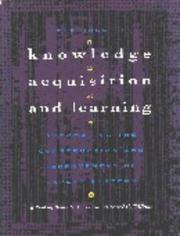
ISBN: 1558601635 Year: 1993 Publisher: San Mateo Kaufmann
Abstract | Keywords | Export | Availability | Bookmark
 Loading...
Loading...Choose an application
- Reference Manager
- EndNote
- RefWorks (Direct export to RefWorks)
Knowledge acquisition (Expert systems) --- Machine learning --- #PEDA *P 024 --- Learning, Machine --- Artificial intelligence --- Machine theory --- Acquisition, Knowledge (Expert systems) --- Expertise acquisition (Expert systems) --- Expert systems (Computer science) --- Artificial intelligence. Robotics. Simulation. Graphics
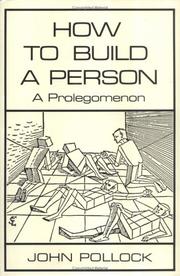
ISBN: 0262161133 9780262512237 9780262281768 0585336997 9780585336992 0262281767 9780262161138 Year: 1989 Publisher: Cambridge, Mass. : MIT Press,
Abstract | Keywords | Export | Availability | Bookmark
 Loading...
Loading...Choose an application
- Reference Manager
- EndNote
- RefWorks (Direct export to RefWorks)
Pollock describes an exciting theory of rationality and its partial implementation in OSCAR, a computer system whose descendants will literally be persons.Building a person has been an elusive goal in artificial intelligence. This failure, John Pollock argues, is because the problems involved are essentially philosophical; what is needed for the construction of a person is a physical system that mimics human rationality. Pollock describes an exciting theory of rationality and its partial implementation in OSCAR, a computer system whose descendants will literally be persons. In developing the philosophical superstructure for this bold undertaking, Pollock defends the conception of man as an intelligent machine and argues that mental states are physical states and persons are physical objects as described in the fable of Oscar, the self conscious machine. Pollock brings a unique blend of philosophy and artificial intelligence to bear on the vexing problem of how to construct a physical system that thinks, is self conscious, has desires, fears, intentions, and a full range of mental states. He brings together an impressive array of technical work in philosophy to drive theory construction in AI. The result is described in his final chapter on "cognitive carpentry."A Bradford Book
Philosophical anthropology --- Artificial intelligence. Robotics. Simulation. Graphics --- Apprentissage automatique --- Automatisch aanleren --- Learning [Machine ] --- Machine learning --- Artificial intelligence --- -Machine learning --- Learning, Machine --- Machine theory --- AI (Artificial intelligence) --- Artificial thinking --- Electronic brains --- Intellectronics --- Intelligence, Artificial --- Intelligent machines --- Machine intelligence --- Thinking, Artificial --- Bionics --- Cognitive science --- Digital computer simulation --- Electronic data processing --- Logic machines --- Self-organizing systems --- Simulation methods --- Fifth generation computers --- Neural computers --- Philosophy --- E-books --- Machine learning. --- Philosophy. --- COGNITIVE SCIENCES/General --- PHILOSOPHY/General
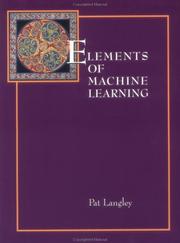
ISBN: 1558603018 Year: 1996 Volume: *3 Publisher: San Francisco Morgan Kaufmann
Abstract | Keywords | Export | Availability | Bookmark
 Loading...
Loading...Choose an application
- Reference Manager
- EndNote
- RefWorks (Direct export to RefWorks)
Artificial intelligence. Robotics. Simulation. Graphics --- Apprentissage automatique --- Automatisch aanleren --- Begrippen --- Concepten --- Concepts --- Learning [Machine ] --- Machine learning --- Machine learning. --- #PEDA *P 024 --- 681.3*I26 --- Learning, Machine --- Artificial intelligence --- Machine theory --- Learning: analogies; concept learning; induction; knowledge acquisition; language acquisition; parameter learning (Artificial intelligence)--See also {681.3*K32} --- 681.3*I26 Learning: analogies; concept learning; induction; knowledge acquisition; language acquisition; parameter learning (Artificial intelligence)--See also {681.3*K32}
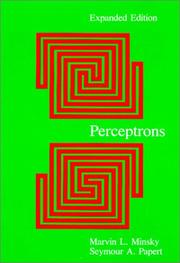
ISBN: 0262631113 9780262631112 Year: 1988 Publisher: Cambridge, MA : M.I.T. Press,
Abstract | Keywords | Export | Availability | Bookmark
 Loading...
Loading...Choose an application
- Reference Manager
- EndNote
- RefWorks (Direct export to RefWorks)
Apprentissage automatique --- Automatisch aanleren --- Learning [Machine ] --- Machine learning --- Parallel processing (Electronic computers) --- Parallelle verwerking (Computers) --- Perceptronen --- Perceptrons --- Traitement parallèle (Ordinateurs) --- Artificial intelligence. Robotics. Simulation. Graphics --- Computer architecture. Operating systems --- Geometry --- Machine Learning --- Data processing --- Machine learning. --- Parallel processing (Electronic computers). --- Perceptrons. --- Data processing. --- Neural networks (Computer science) --- Pattern recognition systems --- Self-organizing systems --- Conscious automata --- High performance computing --- Multiprocessors --- Parallel programming (Computer science) --- Supercomputers --- Learning, Machine --- Artificial intelligence --- Machine theory --- Géométrie --- Parallélisme (Informatique) --- Informatique --- Geometry - Data processing. --- Computer science --- Artificial intelligence. --- Geometry - Data processing
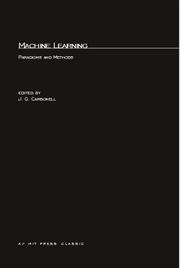
ISBN: 0262530880 Year: 1990 Volume: 2 Publisher: Cambridge London MIT Press
Abstract | Keywords | Export | Availability | Bookmark
 Loading...
Loading...Choose an application
- Reference Manager
- EndNote
- RefWorks (Direct export to RefWorks)
Artificial intelligence. Robotics. Simulation. Graphics --- AI(Artificial intelligence) --- Apprentissage automatique --- Artificial intelligence --- Artificial thinking --- Artificiële intelligentie --- Automatisch aanleren --- Electronic brains --- Intellectronics --- Intelligence [Artificial ] --- Intelligence artificielle --- Intelligent machines --- Kunstmatige intelligentie --- Learning [Machine ] --- Machine intelligence --- Machine learning --- Thinking [Artificial ] --- Cerveaux électroniques --- Machines intelligentes --- Pensée artificielle
Book
ISBN: 9780262018029 0262018020 0262305240 0262304325 9780262305242 Year: 2012 Publisher: London, England: MIT Press,
Abstract | Keywords | Export | Availability | Bookmark
 Loading...
Loading...Choose an application
- Reference Manager
- EndNote
- RefWorks (Direct export to RefWorks)
"Today's Web-enabled deluge of electronic data calls for automated methods of data analysis. Machine learning provides these, developing methods that can automatically detect patterns in data and then use the uncovered patterns to predict future data. This textbook offers a comprehensive and self-contained introduction to the field of machine learning, based on a unified, probabilistic approach. The coverage combines breadth and depth, offering necessary background material on such topics as probability, optimization, and linear algebra as well as discussion of recent developments in the field, including conditional random fields, L1 regularization, and deep learning. The book is written in an informal, accessible style, complete with pseudo-code for the most important algorithms. All topics are copiously illustrated with color images and worked examples drawn from such application domains as biology, text processing, computer vision, and robotics. Rather than providing a cookbook of different heuristic methods, the book stresses a principled model-based approach, often using the language of graphical models to specify models in a concise and intuitive way. Almost all the models described have been implemented in a MATLAB software package--PMTK (probabilistic modeling toolkit)--that is freely available online. The book is suitable for upper-level undergraduates with an introductory-level college math background and beginning graduate students."--Provided by publisher.
Machine learning --- Probabilities --- Apprentissage automatique --- Probabilités --- Machine Learning --- Machine learning. --- Probabilities. --- Basic Sciences. Statistics --- Probability Theory, Sampling Theory --- Artificial intelligence. Robotics. Simulation. Graphics --- Probability Theory, Sampling Theory. --- Probabilités --- Probability --- Statistical inference --- Combinations --- Mathematics --- Chance --- Least squares --- Mathematical statistics --- Risk --- Learning, Machine --- Artificial intelligence --- Machine theory --- Apprentissage automatique. --- Probabilités. --- machine learning --- KI (kunstmatige intelligentie) --- Aprendizaje automático --- Probabilidades --- Libros electrónicos
Book
ISBN: 9781617294433 1617294438 Year: 2017 Publisher: Shelter Island Manning Publications
Abstract | Keywords | Export | Availability | Bookmark
 Loading...
Loading...Choose an application
- Reference Manager
- EndNote
- RefWorks (Direct export to RefWorks)
Artificial intelligence. Robotics. Simulation. Graphics --- Python (Computer program language) --- Machine Learning --- Neural networks (Computer science) --- Artificiële intelligentie --- Machine learning --- Machine learning. --- Neural networks (Computer science). --- Python (Computer program language). --- Machinaal leren --- Scripting languages (Computer science) --- Artificial neural networks --- Nets, Neural (Computer science) --- Networks, Neural (Computer science) --- Neural nets (Computer science) --- Artificial intelligence --- Natural computation --- Soft computing --- Learning, Machine --- Machine theory
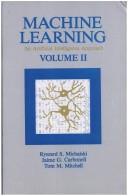
ISBN: 0935382054 Year: 1983 Publisher: Palo Alto Tioga
Abstract | Keywords | Export | Availability | Bookmark
 Loading...
Loading...Choose an application
- Reference Manager
- EndNote
- RefWorks (Direct export to RefWorks)
Artificial intelligence. --- Machine learning --- Learning, Machine --- Artificial intelligence --- Machine theory --- AI (Artificial intelligence) --- Artificial thinking --- Electronic brains --- Intellectronics --- Intelligence, Artificial --- Intelligent machines --- Machine intelligence --- Thinking, Artificial --- Bionics --- Cognitive science --- Digital computer simulation --- Electronic data processing --- Logic machines --- Self-organizing systems --- Simulation methods --- Fifth generation computers --- Neural computers --- Artificial intelligence. Robotics. Simulation. Graphics
| Listing 1 - 10 of 36 | << page >> |
Sort by
|

 Search
Search Feedback
Feedback About
About Help
Help News
News